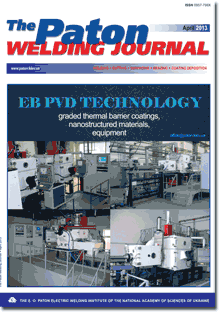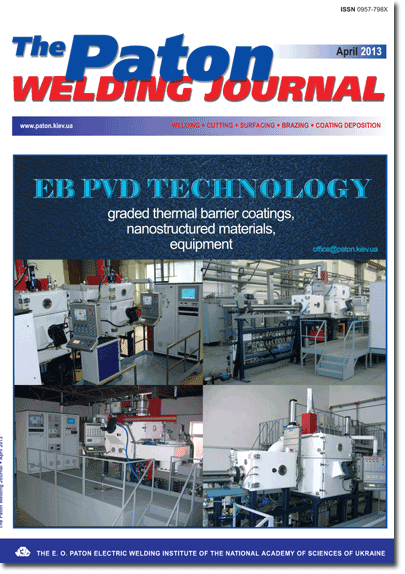| 2013 №04 (12) | 2013 №04 (02) |

The Paton Welding Journal, 2013, #4, 2-7 pages
NUMERICAL MODELLING OF HEAT TRANSFER AND HYDRODYNAMICS IN LASER-PLASMA TREATMENT OF METALLIC MATERIALS
Yu.S. BORISOV, V.F. DEMCHENKO, A.B. LESNOJ, V.Yu. KHASKIN and I.V. SHUBA
E.O. Paton Electric Welding Institute, NASU, Kiev, Ukraine
Abstract
An approximate mathematical model is proposed to describe thermal and hydrodynamic processes occurring in combined laser-plasma cladding. The scheme of a rapidly moving heat source, which generalises the known N.N. Rykalin's scheme for a case of combined convective-conductive heat transfer in molten metal, is considered. Densities of the different-power laser and plasma heat sources are assumed to be distributed on the plate surface by the normal law, having different radii of heat spots. The combined heat spot is assumed to be additive. The equation of local heat balance on the surface of a workpiece allows for heat transfer by radiation and heat losses for evaporation. It is assumed that motion of the melt under the indirect-action plasma heating conditions is driven by the Archimedes buoyancy force and thermocapillary force. Verification of the mathematical model was carried out, and results of calculation experiments on investigation of the penetration zone under the effect of the laser and combined laser-plasma heat sources are described. It is shown that the Marangoni force is a dominant force factor determining hydrodynamics of the melt. The effect of convective energy transfer on formation of the molten zone was studied. 8 Ref., 4 Tables, 8 Figures.
Keywords: laser-plasma cladding, thermal and hydrodynamic processes, modelling, heat transfer, heat balance, cladding, penetration zone, Marangoni force
Received: 24.01.13
Published: 28.04.13
References
1. Duley, U. (1986) Laser processing and analysis of materials. Moscow: Mir.
2. Arutyunyan, R.V., Baranov, V.Yu., Bolshov, L.A. et al. (1989) Effect of laser radiation on materials. Moscow: Nauka.
3. Vedenov, A.A., Gladush, G.G. (1985) Physical processes in laser treatment of materials. Moscow: Energoatomizdat.
4. Rykalin, N.N. (1951) Calculation of thermal processes in welding. Moscow: Mashgiz.
5. Knight, Ch.J. (1979) Theoretical modeling of rapid surface vaporization with back pressure. AIAA J., 17(5), 519-523.
6. Demchenko, V.F., Krivtsun, I.V., Semyonov, I.L. et al. (2009) Mathematical modelling of the processes of heating and convective evaporation of metals under the effect of pulse laser radiation. In: Proc. of 4th Int. Conf. on Beam Technologies and Laser Application (Saint-Petersburg, 23-25 Sept. 2009). Saint-Petersburg: StPPU, 81-85.
7. Lyashko, I.I., Demchenko, V.F., Vakulenko, S.A. (1981) Variant of the method for splitting of equations of dynamics of the viscous incompressible fluid on the Lagrangian-Eulerian networks. Doklady AN USSR. Series A, 43-47.
8. Demchenko, V.F., Lesnoj, A.B. (2000) Lagrangian-Eulerian method of numerical solution of multidimensional problems of convective diffusion. Doklady NAN Ukrainu, 11, 71-75.
Suggested Citation
Yu.S. BORISOV, V.F. DEMCHENKO, A.B. LESNOJ, V.Yu. KHASKIN and I.V. SHUBA (2013) NUMERICAL MODELLING OF HEAT TRANSFER AND HYDRODYNAMICS IN LASER-PLASMA TREATMENT OF METALLIC MATERIALS. The Paton Welding J., 04, 2-7.The cost of subscription/purchase order journals or individual articles
| Journal/Currency | Annual Set | 1 issue printed |
1 issue |
one article |
| TPWJ/USD | 384 $ | 32 $ | 26 $ | 13 $ |
| TPWJ/EUR | 348 € | 29 € | 24 € | 12 € |
| TPWJ/UAH | 7200 UAH | 600 UAH | 600 UAH | 280 UAH |
| AS/UAH | 1800 UAH | 300 UAH | 300 UAH | 150 UAH |
| AS/USD | 192 $ | 32 $ | 26 $ | 13 $ |
| AS/EUR | 180 € | 30 € | 25 € | 12 € |
| SEM/UAH | 1200 UAH | 300 UAH | 300 UAH | 150 UAH |
| SEM/USD | 128 $ | 32 $ | 26 $ | 13 $ |
| SEM/EUR | 120 € | 30 € | 25 € | 12 € |
| TDNK/UAH | 1200 UAH | 300 UAH | 300 UAH | 150 UAH |
| TDNK/USD | 128 $ | 32 $ | 26 $ | 13 $ |
| TDNK/EUR | 120 € | 30 € | 25 € | 15 € |
AS = «Automatic Welding» - 6 issues per year;
TPWJ = «PATON WELDING JOURNAL» - 12 issues per year;
SEM = «Electrometallurgy Today» - 4 issues per year;
TDNK = «Technical Diagnostics and Non-Destructive Testing» - 4 issues per year.


